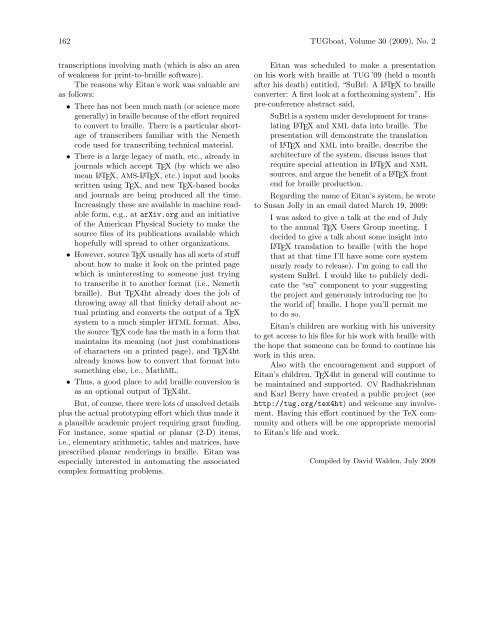The Communications of the TEX Users Group Volume 30 ... - TUG
The Communications of the TEX Users Group Volume 30 ... - TUG
The Communications of the TEX Users Group Volume 30 ... - TUG
Create successful ePaper yourself
Turn your PDF publications into a flip-book with our unique Google optimized e-Paper software.
162 <strong>TUG</strong>boat, <strong>Volume</strong> <strong>30</strong> (2009), No. 2<br />
transcriptions involving math (which is also an area<br />
<strong>of</strong> weakness for print-to-braille s<strong>of</strong>tware).<br />
<strong>The</strong> reasons why Eitan’s work was valuable are<br />
as follows:<br />
• <strong>The</strong>re has not been much math (or science more<br />
generally)inbraillebecause<strong>of</strong><strong>the</strong>effortrequired<br />
to convert to braille. <strong>The</strong>re is a particular shortage<br />
<strong>of</strong> transcribers familiar with <strong>the</strong> Nemeth<br />
code used for transcribing technical material.<br />
• <strong>The</strong>re is a large legacy <strong>of</strong> math, etc., already in<br />
journals which accept <strong>TEX</strong> (by which we also<br />
mean L A<strong>TEX</strong>, AMS-L A<strong>TEX</strong>, etc.) input and books<br />
written using <strong>TEX</strong>, and new <strong>TEX</strong>-based books<br />
and journals are being produced all <strong>the</strong> time.<br />
Increasingly <strong>the</strong>se are available in machine readable<br />
form, e.g., at arXiv.org and an initiative<br />
<strong>of</strong> <strong>the</strong> American Physical Society to make <strong>the</strong><br />
source files <strong>of</strong> its publications available which<br />
hopefully will spread to o<strong>the</strong>r organizations.<br />
• However, source<strong>TEX</strong>usuallyhasallsorts<strong>of</strong>stuff<br />
about how to make it look on <strong>the</strong> printed page<br />
which is uninteresting to someone just trying<br />
to transcribe it to ano<strong>the</strong>r format (i.e., Nemeth<br />
braille). But <strong>TEX</strong>4ht already does <strong>the</strong> job <strong>of</strong><br />
throwing away all that finicky detail about actual<br />
printing and converts <strong>the</strong> output <strong>of</strong> a <strong>TEX</strong><br />
system to a much simpler HTML format. Also,<br />
<strong>the</strong> source <strong>TEX</strong> code has <strong>the</strong> math in a form that<br />
maintains its meaning (not just combinations<br />
<strong>of</strong> characters on a printed page), and <strong>TEX</strong>4ht<br />
already knows how to convert that format into<br />
something else, i.e., MathML.<br />
• Thus, a good place to add braille conversion is<br />
as an optional output <strong>of</strong> <strong>TEX</strong>4ht.<br />
But, <strong>of</strong>course, <strong>the</strong>rewerelots<strong>of</strong>unsolveddetails<br />
plus <strong>the</strong> actual prototyping effort which thus made it<br />
a plausible academic project requiring grant funding.<br />
For instance, some spatial or planar (2-D) items,<br />
i.e., elementary arithmetic, tables and matrices, have<br />
prescribed planar renderings in braille. Eitan was<br />
especially interested in automating <strong>the</strong> associated<br />
complex formatting problems.<br />
Eitan was scheduled to make a presentation<br />
on his work with braille at <strong>TUG</strong>’09 (held a month<br />
after his death) entitled, “SuBrl: A L A<strong>TEX</strong> to braille<br />
converter: A first look at a forthcoming system”. His<br />
pre-conference abstract said,<br />
SuBrlisasystemunderdevelopmentfortranslating<br />
L A<strong>TEX</strong> and XML data into braille. <strong>The</strong><br />
presentation will demonstrate <strong>the</strong> translation<br />
<strong>of</strong> L A<strong>TEX</strong> and XML into braille, describe <strong>the</strong><br />
architecture <strong>of</strong> <strong>the</strong> system, discuss issues that<br />
require special attention in L A<strong>TEX</strong> and XML<br />
sources, and argue <strong>the</strong> benefit <strong>of</strong> a L A<strong>TEX</strong> front<br />
end for braille production.<br />
Regarding <strong>the</strong> name <strong>of</strong> Eitan’s system, he wrote<br />
to Susan Jolly in an email dated March 19, 2009:<br />
I was asked to give a talk at <strong>the</strong> end <strong>of</strong> July<br />
to <strong>the</strong> annual <strong>TEX</strong> <strong>Users</strong> <strong>Group</strong> meeting. I<br />
decided to give a talk about some insight into<br />
L A<strong>TEX</strong> translation to braille (with <strong>the</strong> hope<br />
that at that time I’ll have some core system<br />
nearly ready to release). I’m going to call <strong>the</strong><br />
system SuBrl. I would like to publicly dedicate<br />
<strong>the</strong> “su” component to your suggesting<br />
<strong>the</strong> project and generously introducing me [to<br />
<strong>the</strong> world <strong>of</strong>] braille. I hope you’ll permit me<br />
to do so.<br />
Eitan’s children are working with his university<br />
to get access to his files for his work with braille with<br />
<strong>the</strong> hope that someone can be found to continue his<br />
work in this area.<br />
Also with <strong>the</strong> encouragement and support <strong>of</strong><br />
Eitan’s children, <strong>TEX</strong>4ht in general will continue to<br />
be maintained and supported. CV Radhakrishnan<br />
and Karl Berry have created a public project (see<br />
http://tug.org/tex4ht) and welcome any involvement.<br />
Having this effort continued by <strong>the</strong> TeX community<br />
and o<strong>the</strong>rs will be one appropriate memorial<br />
to Eitan’s life and work.<br />
Compiled by David Walden, July 2009

















